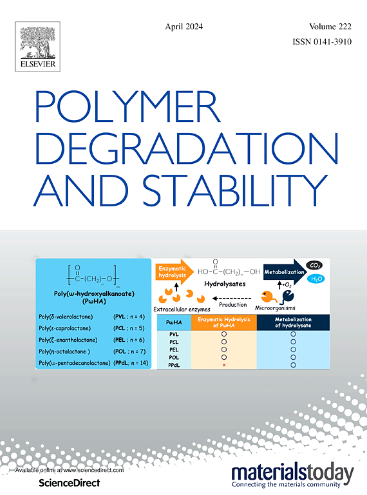阻燃剂含量极低的硬质聚氨酯泡沫的高效阻燃性和火灾蔓延行为
IF 6.3
2区 化学
Q1 POLYMER SCIENCE
引用次数: 0
摘要
近年来,由于建筑节能领域的需求日益增长,阻燃硬质聚氨酯泡沫(RPUF)再次吸引了学者们的目光。然而,RPUF 本身的易燃性很高,而且人们对其阻燃机制的复杂性仍然了解不足。本研究成功合成了一种改性生物质材料--氨基淀粉磷酸酯,然后将其与可膨胀石墨(EG)结合并加入到 RPUF 中。研究深入探讨了达到严格的 UL-94 V-0 等级所需的最佳比例和最小阻燃添加剂,同时还对复合材料系统的阻燃性能和热性能进行了深入研究。研究结果表明,RPUF 只需 6 wt.%的阻燃剂就能达到 UL-94 V-0 级标准,峰值热释放率(pHRR)降低了 41.1%,总热释放率(THR)降低了 23.7%。此外,它还能减小火焰的大小和宽度,使火焰更快熄灭,同时降低聚氨酯的内部燃烧温度,从而延迟预热和燃烧时间。在燃烧过程中,氨基淀粉磷酸酯和 EG 之间的协同作用会形成致密、连续的炭层,从而有效抑制 RPUF 的热解和燃烧。这项研究为开发用于 RPUF 的高效阻燃系统提供了理论基础。本文章由计算机程序翻译,如有差异,请以英文原文为准。
Highly efficient flame retardancy and fire spread behavior of rigid polyurethane foams with extremely low content of flame retardant
In recent years, flame-retardant rigid polyurethane foam (RPUF) has once again captured the scholars’ attention due to the growing the growing demands in the field of building energy efficiency. However, the inherent flammability of RPUF is high and the complexities of its flame-retardant mechanisms remain inadequately understood. In this study, a modified biomass material, amino starch phosphate ester was successfully synthesized which was then combined with expandable graphite (EG) and incorporated into RPUF. The research delved into the optimal ratio and minimal flame-retardant additive required to achieve the stringent UL-94 V-0 rating, while also thoroughly investigating the flame retardancy and thermal properties of the composite system. The findings revealed that with just 6 wt.% of flame retardants, the RPUF achieved the UL-94 V-0 rating, with a 41.1 % reduction in peak heat release rate (pHRR) and a 23.7 % decrease in total heat release (THR). Additionally, it diminishes the flame's size and width, leading to quicker extinction, while also lowering the internal combustion temperature of the polyurethane, thereby delaying both preheating and combustion times. The synergistic interaction between amino starch phosphate ester and EG during combustion results in the formation of a dense, continuous char layer, effectively inhibiting the pyrolysis and combustion of RPUF. This study provides a theoretical foundation for the development of efficient flame-retardant systems for RPUF.
求助全文
通过发布文献求助,成功后即可免费获取论文全文。
去求助
来源期刊

Polymer Degradation and Stability
化学-高分子科学
CiteScore
10.10
自引率
10.20%
发文量
325
审稿时长
23 days
期刊介绍:
Polymer Degradation and Stability deals with the degradation reactions and their control which are a major preoccupation of practitioners of the many and diverse aspects of modern polymer technology.
Deteriorative reactions occur during processing, when polymers are subjected to heat, oxygen and mechanical stress, and during the useful life of the materials when oxygen and sunlight are the most important degradative agencies. In more specialised applications, degradation may be induced by high energy radiation, ozone, atmospheric pollutants, mechanical stress, biological action, hydrolysis and many other influences. The mechanisms of these reactions and stabilisation processes must be understood if the technology and application of polymers are to continue to advance. The reporting of investigations of this kind is therefore a major function of this journal.
However there are also new developments in polymer technology in which degradation processes find positive applications. For example, photodegradable plastics are now available, the recycling of polymeric products will become increasingly important, degradation and combustion studies are involved in the definition of the fire hazards which are associated with polymeric materials and the microelectronics industry is vitally dependent upon polymer degradation in the manufacture of its circuitry. Polymer properties may also be improved by processes like curing and grafting, the chemistry of which can be closely related to that which causes physical deterioration in other circumstances.
 求助内容:
求助内容: 应助结果提醒方式:
应助结果提醒方式:


